Check Alfa Romeo Giulietta 2013 Owner handbook (in English)
[x] Cancel search | Manufacturer: ALFA ROMEO, Model Year: 2013, Model line: Giulietta, Model: Alfa Romeo Giulietta 2013Pages: 292, PDF Size: 13.06 MB
Page 182 of 292
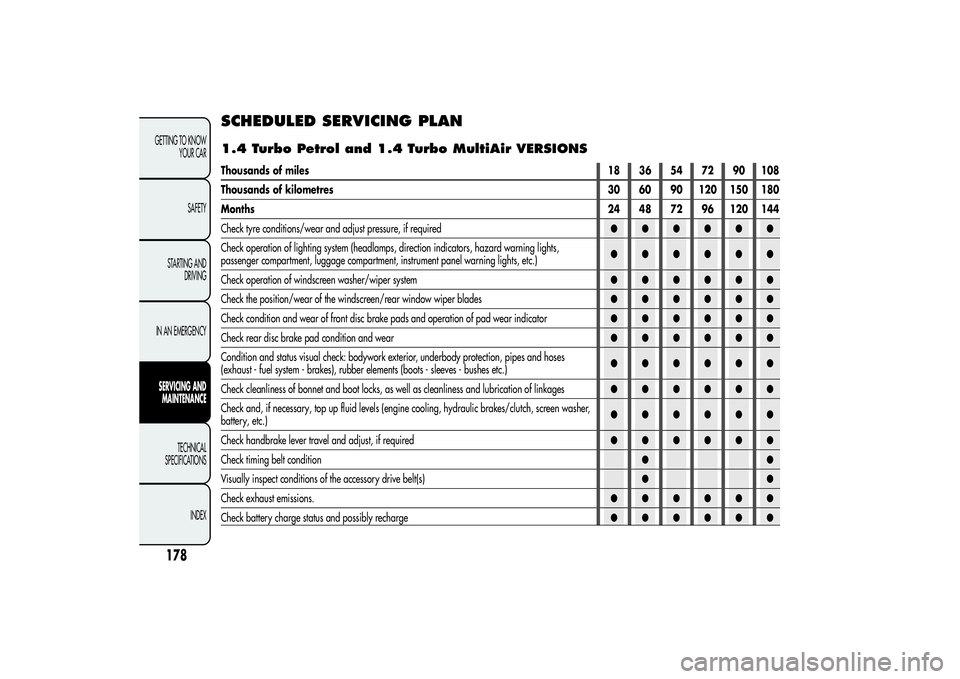
SCHEDULED SERVICING PLAN1.4 Turbo Petrol and 1.4 Turbo MultiAir VERSIONSThousands of miles18 36 54 72 90 108
Thousands of kilometres 30 60 90 120 150 180
Months24 48 72 96 120 144
Check tyre conditions/wear and adjust pressure, if required●●●●●●
Check operation of lighting system (headlamps, direction indicators, hazard warning lights,
passenger compartment, luggage compartment, instrument panel warning lights, etc.)●●●●●●
Check operation of windscreen washer/wiper system●●●●●●
Check the position/wear of the windscreen/rear window wiper blades●●●●●●
Check condition and wear of front disc brake pads and operation of pad wear indicator●●●●●●
Check rear disc brake pad condition and wear●●●●●●
Condition and status visual check: bodywork exterior, underbody protection, pipes and hoses
(exhaust - fuel system - brakes), rubber elements (boots - sleeves - bushes etc.)●●●●●●
Check cleanliness of bonnet and boot locks, as well as cleanliness and lubrication of linkages●●●●●●
Check and, if necessary, top up fluid levels (engine cooling, hydraulic brakes/clutch, screen washer,
battery, etc.)●●●●●●
Check handbrake lever travel and adjust, if required●●●●●●
Check timing belt condition●●
Visually inspect conditions of the accessory drive belt(s)●●
Check exhaust emissions.●●●●●●
Check battery charge status and possibly recharge●●●●●●
178GETTING TO KNOW
YOUR CAR
SAFETY
STARTING AND
DRIVING
IN AN EMERGENCYSERVICING AND
MAINTENANCE
TECHNICAL
SPECIFICATIONS
INDEX
Page 183 of 292
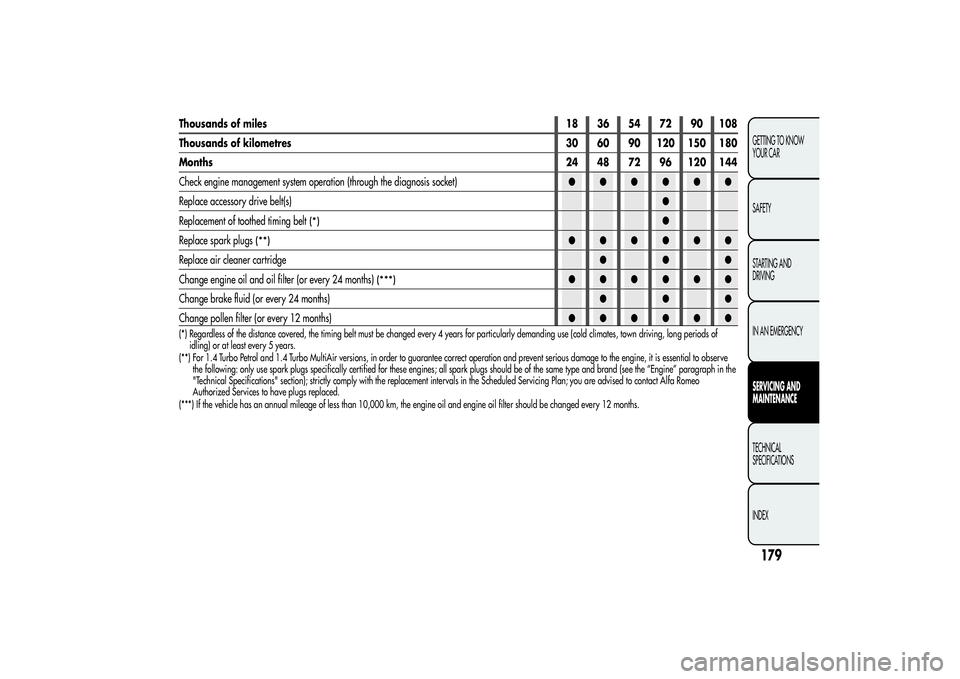
Thousands of miles18 36 54 72 90 108
Thousands of kilometres 30 60 90 120 150 180
Months24 48 72 96 120 144
Check engine management system operation (through the diagnosis socket)●●●●●●
Replace accessory drive belt(s)●
Replacement of toothed timing belt
(*)
●
Replace spark plugs
(**)
●●●●●●
Replace air cleaner cartridge●●●
Change engine oil and oil filter (or every 24 months)
(***)
●●●●●●
Change brake fluid (or every 24 months)●●●
Change pollen filter (or every 12 months)●●●●●●
(*) Regardless of the distance covered, the timing belt must be changed every 4 years for particularly demanding use (cold climates, town driving, long periods of
idling) or at least every 5 years.
(**) For 1.4 Turbo Petrol and 1.4 Turbo MultiAir versions, in order to guarantee correct operation and prevent serious damage to the engine, it is essential to observe
the following: only use spark plugs specifically certified for these engines; all spark plugs should be of the same type and brand (see the “Engine” paragraph in the
"Technical Specifications" section); strictly comply with the replacement intervals in the Scheduled Servicing Plan; you are advised to contact Alfa Romeo
Authorized Services to have plugs replaced.
(***) If the vehicle has an annual mileage of less than 10,000 km, the engine oil and engine oil filter should be changed every 12 months.
179GETTING TO KNOW
YOUR CAR
SAFETY
STARTING AND
DRIVING
IN AN EMERGENCYSERVICING AND
MAINTENANCETECHNICAL
SPECIFICATIONS
INDEX
Page 184 of 292
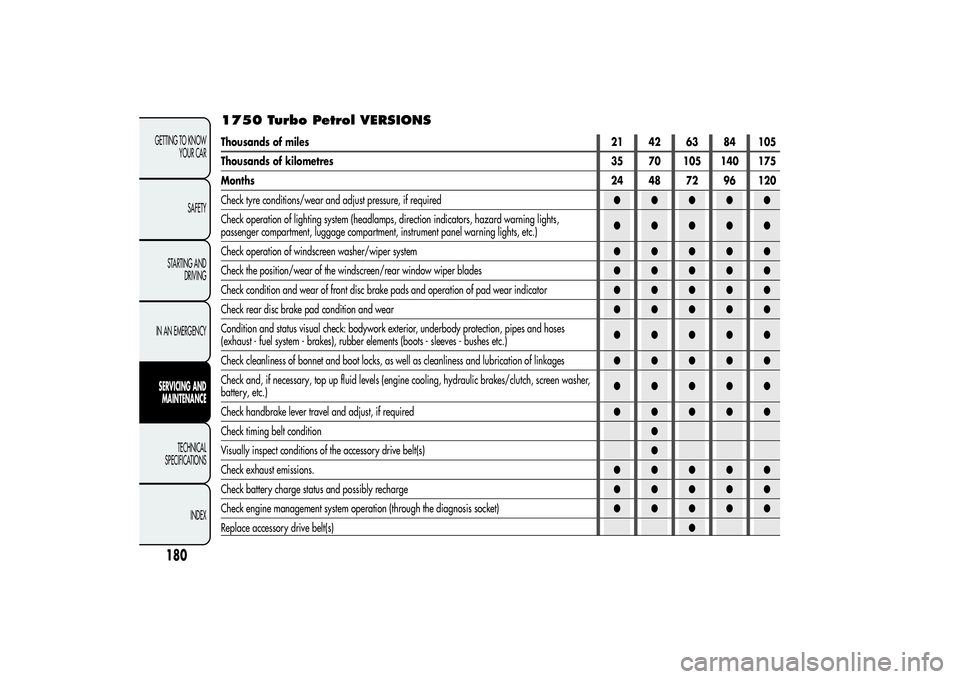
1750 Turbo Petrol VERSIONSThousands of miles21 42 63 84 105
Thousands of kilometres 35 70 105 140 175
Months24 48 72 96 120
Check tyre conditions/wear and adjust pressure, if required●●●●●
Check operation of lighting system (headlamps, direction indicators, hazard warning lights,
passenger compartment, luggage compartment, instrument panel warning lights, etc.)●●●●●
Check operation of windscreen washer/wiper system●●●●●
Check the position/wear of the windscreen/rear window wiper blades●●●●●
Check condition and wear of front disc brake pads and operation of pad wear indicator●●●●●
Check rear disc brake pad condition and wear●●●●●
Condition and status visual check: bodywork exterior, underbody protection, pipes and hoses
(exhaust - fuel system - brakes), rubber elements (boots - sleeves - bushes etc.)●●●●●
Check cleanliness of bonnet and boot locks, as well as cleanliness and lubrication of linkages●●●●●
Check and, if necessary, top up fluid levels (engine cooling, hydraulic brakes/clutch, screen washer,
battery, etc.)●●●●●
Check handbrake lever travel and adjust, if required●●●●●
Check timing belt condition●
Visually inspect conditions of the accessory drive belt(s)●
Check exhaust emissions.●●●●●
Check battery charge status and possibly recharge●●●●●
Check engine management system operation (through the diagnosis socket)●●●●●
Replace accessory drive belt(s)●
180GETTING TO KNOW
YOUR CAR
SAFETY
STARTING AND
DRIVING
IN AN EMERGENCYSERVICING AND
MAINTENANCE
TECHNICAL
SPECIFICATIONS
INDEX
Page 186 of 292
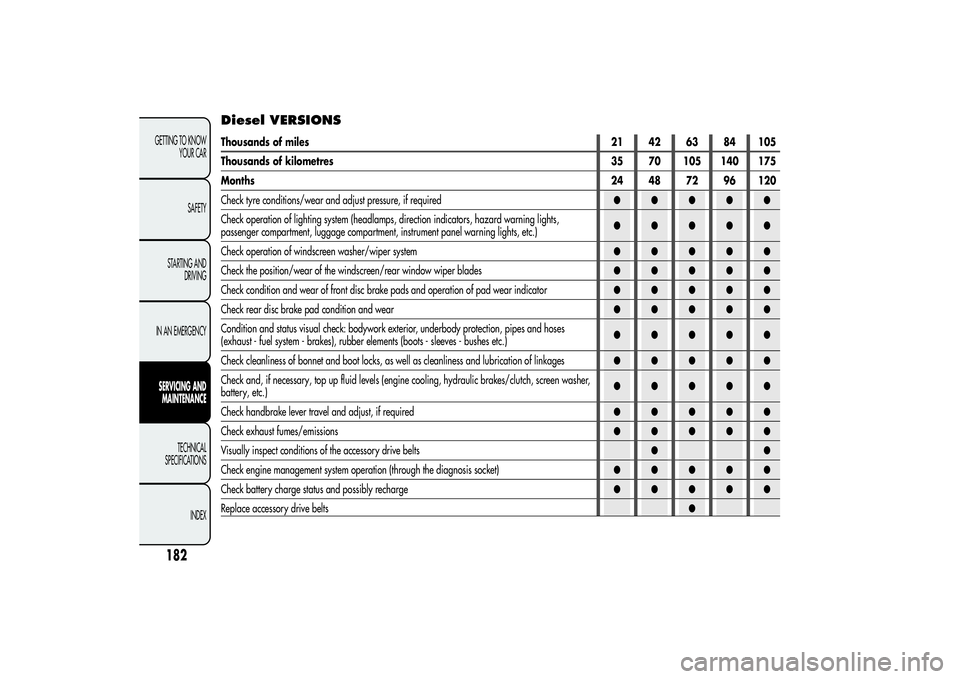
Diesel VERSIONSThousands of miles21 42 63 84 105
Thousands of kilometres 35 70 105 140 175
Months24 48 72 96 120
Check tyre conditions/wear and adjust pressure, if required●●●●●
Check operation of lighting system (headlamps, direction indicators, hazard warning lights,
passenger compartment, luggage compartment, instrument panel warning lights, etc.)●●●●●
Check operation of windscreen washer/wiper system●●●●●
Check the position/wear of the windscreen/rear window wiper blades●●●●●
Check condition and wear of front disc brake pads and operation of pad wear indicator●●●●●
Check rear disc brake pad condition and wear●●●●●
Condition and status visual check: bodywork exterior, underbody protection, pipes and hoses
(exhaust - fuel system - brakes), rubber elements (boots - sleeves - bushes etc.)●●●●●
Check cleanliness of bonnet and boot locks, as well as cleanliness and lubrication of linkages●●●●●
Check and, if necessary, top up fluid levels (engine cooling, hydraulic brakes/clutch, screen washer,
battery, etc.)●●●●●
Check handbrake lever travel and adjust, if required●●●●●
Check exhaust fumes/emissions●●●●●
Visually inspect conditions of the accessory drive belts●●
Check engine management system operation (through the diagnosis socket)●●●●●
Check battery charge status and possibly recharge●●●●●
Replace accessory drive belts●
182GETTING TO KNOW
YOUR CAR
SAFETY
STARTING AND
DRIVING
IN AN EMERGENCYSERVICING AND
MAINTENANCE
TECHNICAL
SPECIFICATIONS
INDEX
Page 188 of 292

PERIODIC CHECKSEvery 1,000 km or before long journeys, check and restore the
following if necessary:
❒engine coolant, brake fluid and windscreen washer fluid level;
❒tyre inflation pressure and condition;
❒operation of lighting system (headlamps, direction indicators,
hazard warning lights, etc.);
❒operation of window washer/wiper system and positioning/wear of
windscreen/rear window wiper blades
Check and top up, if required, the engine oil level every 3,000 km.
HEAVY-DUTY USE OF THE CARIf you use the car mainly under one of the following conditions:
❒towing a trailer or caravan;
❒dusty roads;
❒short, repeated journeys (less than 7-8 km) at sub-zero outside
temperatures;
❒engine often idling or driving long distances at low speeds or long
periods of idleness;
the following checks must be performed more frequently than indicated
in the Scheduled Servicing Plan:
❒check front disc brake pad conditions and wear;
❒check cleanliness of bonnet and boot locks, cleanliness and
lubrication of linkage;
❒visually inspect conditions of: engine, gearbox, transmission, pipes
and hoses (exhaust - fuel system - brakes) and rubber elements
(boots - sleeves - bushes - etc.);
❒check battery charge and battery fluid level (electrolyte);
❒visually inspect condition of the accessory drive belts;
❒check and, if necessary, change engine oil and replace oil filter;
❒check and, if necessary, replace pollen filter;
❒check and, if necessary, replace air cleaner.
184GETTING TO KNOW
YOUR CAR
SAFETY
STARTING AND
DRIVING
IN AN EMERGENCYSERVICING AND
MAINTENANCE
TECHNICAL
SPECIFICATIONS
INDEX
Page 189 of 292

CHECKING LEVELS
When topping up, take care not to mix up the various types
of fluids: they are not compatible with each other and
could seriously damage the car.Never smoke while working in the engine
compartment: gas and inflammable vapours may be
present, with the risk of fire.
Be very careful when working in the engine
compartment when the engine is hot: you may get
burned. Remember that the fan may start up if
the engine is hot: this could injure you. Make sure that scarves,
ties and other loose fitting garments do not get caught up in
moving parts.
185GETTING TO KNOW
YOUR CAR
SAFETY
STARTING AND
DRIVING
IN AN EMERGENCYSERVICING AND
MAINTENANCETECHNICAL
SPECIFICATIONS
INDEX
Page 194 of 292
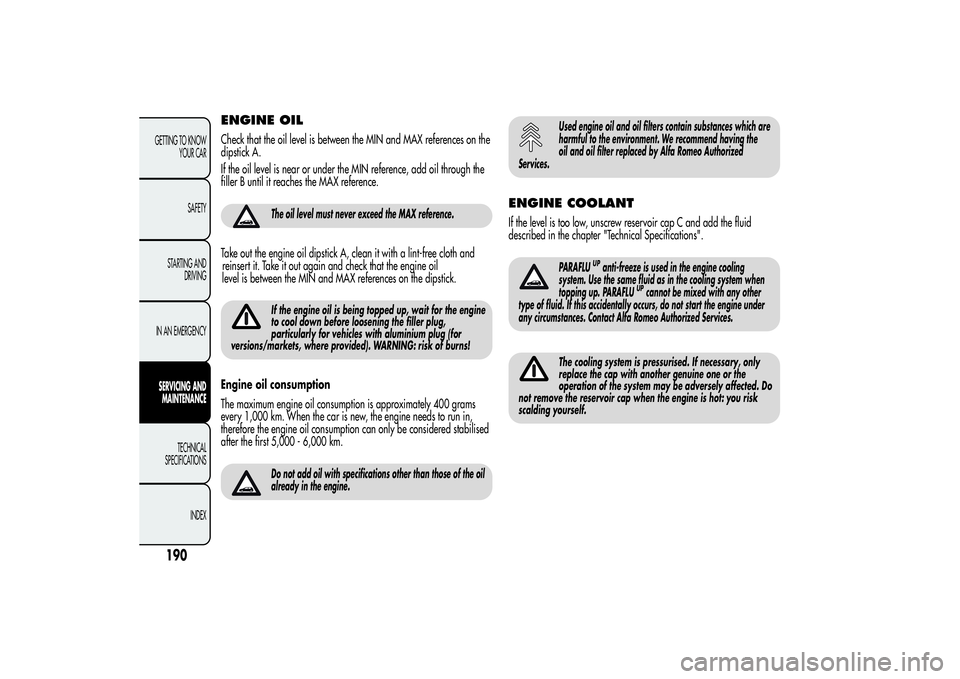
ENGINE OILCheck that the oil level is between the MIN and MAX references on the
dipstick A.
If the oil level is near or under the MIN reference, add oil through the
filler B until it reaches the MAX reference.
The oil level must never exceed the MAX reference.
Take out the engine oil dipstick A, clean it with a lint-free cloth and
reinsert it. Take it out again and check that the engine oil
level is between the MIN and MAX references on the dipstick.
If the engine oil is being topped up, wait for the engine
to cool down before loosening the filler plug,
particularly for vehicles with aluminium plug (for
versions/markets, where provided). WARNING: risk of burns!
Engine oil consumption
The maximum engine oil consumption is approximately 400 grams
every 1,000 km. When the car is new, the engine needs to run in,
therefore the engine oil consumption can only be considered stabilised
after the first 5,000 - 6,000 km.
Do not add oil with specifications other than those of the oil
already in the engine.
Used engine oil and oil filters contain substances which are
harmful to the environment. We recommend having the
oil and oil filter replaced by Alfa Romeo Authorized
Services.
ENGINE COOLANTIf the level is too low, unscrew reservoir cap C and add the fluid
described in the chapter "Technical Specifications".
PARAFLU
UPanti-freeze is used in the engine cooling
system. Use the same fluid as in the cooling system when
topping up. PARAFLU
UPcannot be mixed with any other
type of fluid. If this accidentally occurs, do not start the engine under
any circumstances. Contact Alfa Romeo Authorized Services.
The cooling system is pressurised. If necessary, only
replace the cap with another genuine one or the
operation of the system may be adversely affected. Do
not remove the reservoir cap when the engine is hot: you risk
scalding yourself.
190GETTING TO KNOW
YOUR CAR
SAFETY
STARTING AND
DRIVING
IN AN EMERGENCYSERVICING AND
MAINTENANCE
TECHNICAL
SPECIFICATIONS
INDEX
Page 195 of 292
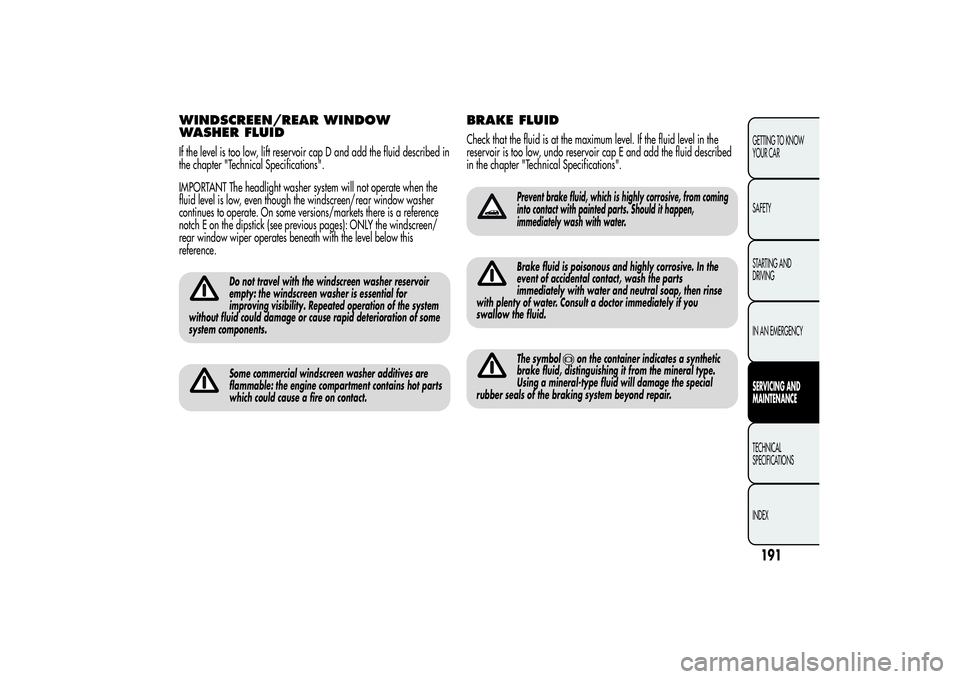
WINDSCREEN/REAR WINDOW
WASHER FLUIDIf the level is too low, lift reservoir cap D and add the fluid described in
the chapter "Technical Specifications".
IMPORTANT The headlight washer system will not operate when the
fluid level is low, even though the windscreen/rear window washer
continues to operate. On some versions/markets there is a reference
notch E on the dipstick (see previous pages): ONLY the windscreen/
rear window wiper operates beneath with the level below this
reference.
Do not travel with the windscreen washer reservoir
empty: the windscreen washer is essential for
improving visibility. Repeated operation of the system
without fluid could damage or cause rapid deterioration of some
system components.Some commercial windscreen washer additives are
flammable: the engine compartment contains hot parts
which could cause a fire on contact.
BRAKE FLUIDCheck that the fluid is at the maximum level. If the fluid level in the
reservoir is too low, undo reservoir cap E and add the fluid described
in the chapter "Technical Specifications".
Prevent brake fluid, which is highly corrosive, from coming
into contact with painted parts. Should it happen,
immediately wash with water.Brake fluid is poisonous and highly corrosive. In the
event of accidental contact, wash the parts
immediately with water and neutral soap, then rinse
with plenty of water. Consult a doctor immediately if you
swallow the fluid.The symbol
on the container indicates a synthetic
brake fluid, distinguishing it from the mineral type.
Using a mineral-type fluid will damage the special
rubber seals of the braking system beyond repair.
191GETTING TO KNOW
YOUR CAR
SAFETY
STARTING AND
DRIVING
IN AN EMERGENCYSERVICING AND
MAINTENANCETECHNICAL
SPECIFICATIONS
INDEX
Page 196 of 292
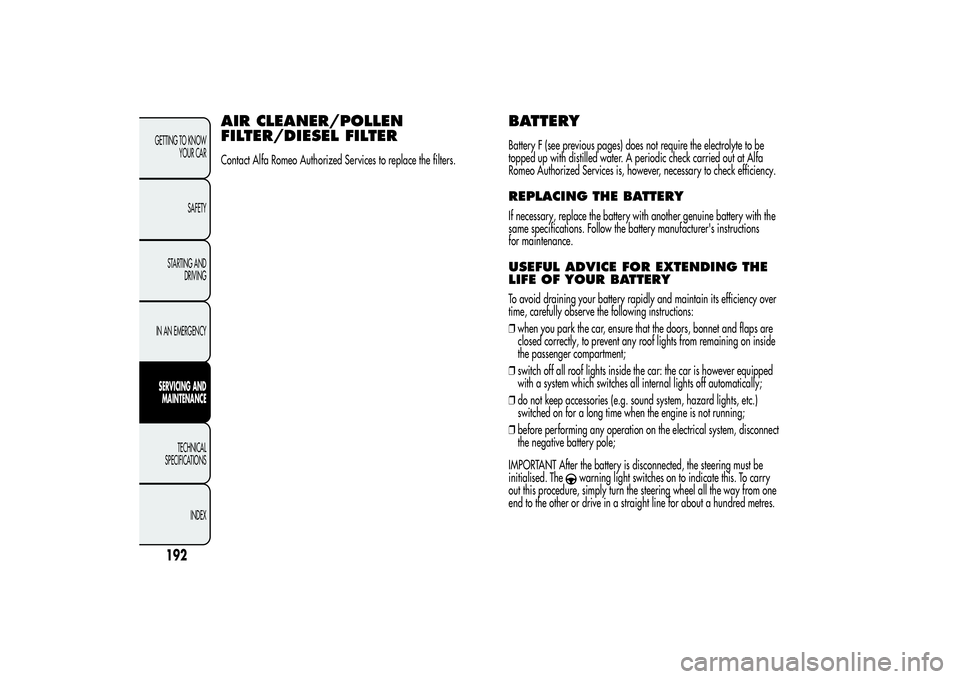
AIR CLEANER/POLLEN
FILTER/DIESEL FILTERContact Alfa Romeo Authorized Services to replace the filters.
BATTERYBattery F (see previous pages) does not require the electrolyte to be
topped up with distilled water. A periodic check carried out at Alfa
Romeo Authorized Services is, however, necessary to check efficiency.REPLACING THE BATTERYIf necessary, replace the battery with another genuine battery with the
same specifications. Follow the battery manufacturer's instructions
for maintenance.USEFUL ADVICE FOR EXTENDING THE
LIFE OF YOUR BATTERYTo avoid draining your battery rapidly and maintain its efficiency over
time, carefully observe the following instructions:
❒when you park the car, ensure that the doors, bonnet and flaps are
closed correctly, to prevent any roof lights from remaining on inside
the passenger compartment;
❒switch off all roof lights inside the car: the car is however equipped
with a system which switches all internal lights off automatically;
❒do not keep accessories (e.g. sound system, hazard lights, etc.)
switched on for a long time when the engine is not running;
❒before performing any operation on the electrical system, disconnect
the negative battery pole;
IMPORTANT After the battery is disconnected, the steering must be
initialised. The
warning light switches on to indicate this. To carry
out this procedure, simply turn the steering wheel all the way from one
end to the other or drive in a straight line for about a hundred metres.
192GETTING TO KNOW
YOUR CAR
SAFETY
STARTING AND
DRIVING
IN AN EMERGENCYSERVICING AND
MAINTENANCE
TECHNICAL
SPECIFICATIONS
INDEX
Page 198 of 292
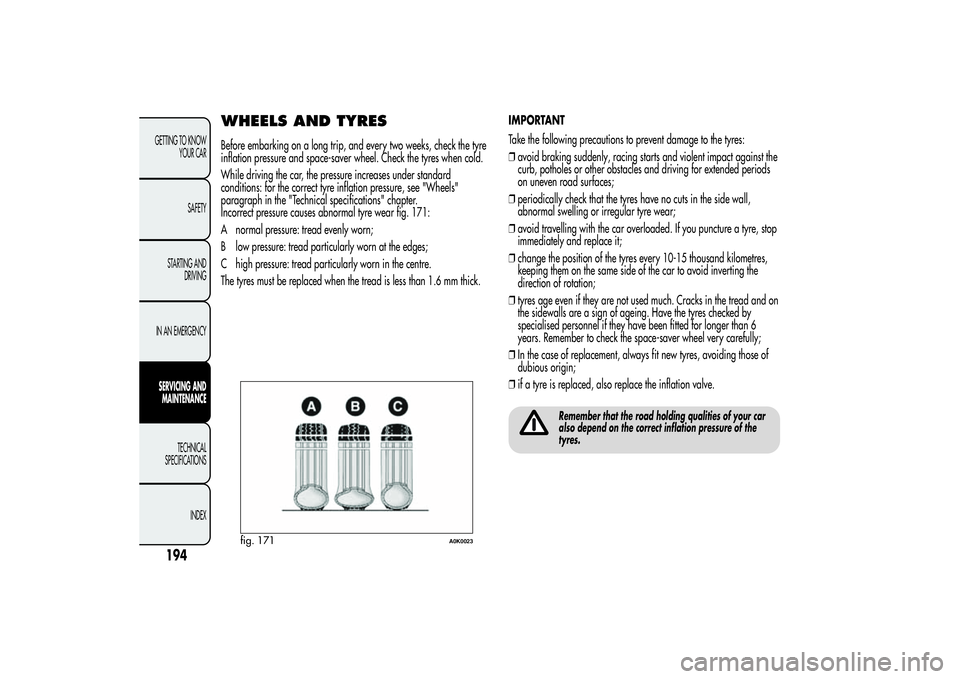
WHEELS AND TYRESBefore embarking on a long trip, and every two weeks, check the tyre
inflation pressure and space-saver wheel. Check the tyres when cold.
While driving the car, the pressure increases under standard
conditions: for the correct tyre inflation pressure, see "Wheels"
paragraph in the "Technical specifications" chapter.
Incorrect pressure causes abnormal tyre wear fig. 171:
A normal pressure: tread evenly worn;
B low pressure: tread particularly worn at the edges;
C high pressure: tread particularly worn in the centre.
The tyres must be replaced when the tread is less than 1.6 mm thick.IMPORTANT
Take the following precautions to prevent damage to the tyres:
❒avoid braking suddenly, racing starts and violent impact against the
curb, potholes or other obstacles and driving for extended periods
on uneven road surfaces;
❒periodically check that the tyres have no cuts in the side wall,
abnormal swelling or irregular tyre wear;
❒avoid travelling with the car overloaded. If you puncture a tyre, stop
immediately and replace it;
❒change the position of the tyres every 10-15 thousand kilometres,
keeping them on the same side of the car to avoid inverting the
direction of rotation;
❒tyres age even if they are not used much. Cracks in the tread and on
the sidewalls are a sign of ageing. Have the tyres checked by
specialised personnel if they have been fitted for longer than 6
years. Remember to check the space-saver wheel very carefully;
❒In the case of replacement, always fit new tyres, avoiding those of
dubious origin;
❒if a tyre is replaced, also replace the inflation valve.
Remember that the road holding qualities of your car
also depend on the correct inflation pressure of the
tyres.
fig. 171
A0K0023
194GETTING TO KNOW
YOUR CAR
SAFETY
STARTING AND
DRIVING
IN AN EMERGENCYSERVICING AND
MAINTENANCE
TECHNICAL
SPECIFICATIONS
INDEX